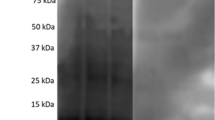Abstract
Schistosoma spindale (Montgomery) is a common trematode parasite of cattle, water buffalo, goats and other mammals over a vast area including southern Africa, South and South-East Asia. It is a close relative of the human parasite S. haematobium and while it has only rarely been reported from man it is a significant producer of cercarial dermatitis in rice field workers. As part of an investigation of S. spindale in Malaysia, a number of laboratory animals were infected in various ways with cercariae of this helminth. One young female white mouse was exposed by tail immersion to numerous cercariae of a local strain in Kuala Lumpur and killed 82 days later with 0.3 ml. of heparinized ‘Nembutal’ (pento-barbital sodium) injected intraperitoneally. The liver and spleen were larger than those usually found in mice with S. spindale infections of similar age. The spleen was soft and yellowish-white and particularly distended over about half its length. Small pieces of liver, spleen, lungs and intestine were fixed in 10% formalin, after which the mouse was perfused with citrated saline according to the method of Duvall and DeWitt1. Eighteen pairs of worms and thirty adult males were recovered in the perfusate; all except one pair and two males had nodular lesions (Fig. 1 b–f) visible to the naked eye or with low magnification. I found several additional worms, including some with such lesions, in the tissues (Fig. 1f), but no affected worms in fifty-seven other mice similarly exposed and perfused. The discovery of these diseased worms was unanticipated. Because their significance was not immediately appreciated, they were fixed with 10% formalin and stored in 70% alcohol as usual. On subsequent examination, it became clear that their nodular lesions were filled with great numbers of cocci (Fig 1g and h) which could by then be identified only as being Gram-positive.
This is a preview of subscription content, access via your institution
Access options
Subscribe to this journal
Receive 51 print issues and online access
$199.00 per year
only $3.90 per issue
Buy this article
- Purchase on Springer Link
- Instant access to full article PDF
Prices may be subject to local taxes which are calculated during checkout
Similar content being viewed by others
References
Duvall, R. H., and DeWitt, W. B., Amer. J. Trop. Med. Hyg., 16, 483 (1967).
Krakower, C., Hoffman, W. A., and Axtmayer, J. A., Puerto Rico J. Pub. Hlth. Trop. Med., 16, 269 (1940).
Ottens, H., and Dickerson, G., Nature, 223, 506 (1969).
Author information
Authors and Affiliations
Rights and permissions
About this article
Cite this article
BASCH, P. Infection of Schistosomes with Gram-positive Cocci. Nature 233, 492–493 (1971). https://doi.org/10.1038/233492a0
Received:
Revised:
Issue Date:
DOI: https://doi.org/10.1038/233492a0
Comments
By submitting a comment you agree to abide by our Terms and Community Guidelines. If you find something abusive or that does not comply with our terms or guidelines please flag it as inappropriate.



